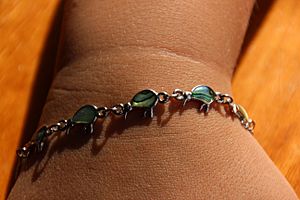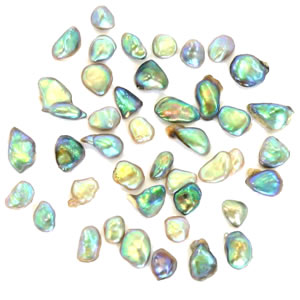Pāua facts for kids
Pāua are special sea snails found in New Zealand. Their Māori name is Pāua, and it's used for three types of large, edible snails. In other places, these snails are called abalone or ormer shells. The word Pāua can mean one snail or many snails, just like in the Māori language.
Contents
Types of Pāua
There are three main types of Pāua found in New Zealand:
| Type | Scientific Name | Other Names |
|---|---|---|
| Pāua | Haliotis iris | Blackfoot Pāua |
| Queen Pāua | Haliotis australis | Silver Pāua, Yellow Foot Pāua, Hihiwa & Karariwha |
| Virgin Pāua | Haliotis virginea | Marapeka & Koio |
The most common and well-known Pāua in New Zealand is Haliotis iris. It can grow quite large, up to 18 centimeters wide.
Where Pāua Live
Pāua usually live in shallow ocean waters. You can find them along rocky coastlines. They prefer depths of about 1 to 10 meters.
Young Pāua and adult Pāua live in different spots. Young Pāua, smaller than 7 centimeters, hide in cracks and under rocks. They stay in the shallow areas where the tide goes in and out. Older, larger Pāua live deeper in the water, below the low tide line.
Life of a Pāua
These big sea snails hold onto rocks very tightly. They use their strong, muscular foot to cling on. This helps them survive strong ocean waves and tides. Pāua eat seaweed to get their energy.
Harvesting Pāua
People collect Pāua for fun and for selling. However, there are strict rules about how many Pāua can be taken. This helps protect them.
Rules for Recreational Fishing
If you are fishing for fun, you can only collect ten Pāua per person each day. There are also rules about how big the Pāua must be. For the common Haliotis iris, the shell must be at least 125 millimeters long. For Haliotis australis, it must be at least 80 millimeters long. These measurements are taken in a straight line across the longest part of the shell.
There's a special rule for Haliotis iris caught near Taranaki. In that area, the minimum size is 85 millimeters. But if you catch them there, you can't take them far inland unless they are 125 millimeters.
You also cannot have more than 20 Pāua in total. Or, if you take the meat out of the shell, you can't have more than 2.5 kilograms of meat.
How Pāua are Caught
Pāua can only be caught by free diving. This means holding your breath and swimming down. It is against the law to use scuba gear to catch Pāua. All Pāua must stay in their shells until you are on land, past the high tide mark. This allows fishery officers to check them if needed.
Protecting Pāua
There's a big problem with Pāua being taken illegally. This is called poaching. Many Pāua are caught when they are too small. This harms the Pāua population. Fishery officers and police work hard to stop poaching. If someone breaks the rules, they can get fines. For serious cases, they might lose their diving gear, boats, or cars.
How People Use Pāua
For Māori people, Pāua are very important. They are considered a taonga, or treasure. Pāua are eaten as delicious seafood. Their shells are also used in traditional and modern art. Pāua shells are often used to make the eyes in Māori carvings. They also represent stars in the night sky.
Pāua are a symbol of New Zealand. Their black, muscular foot is a popular food. The shells are often made into beautiful jewelry.
Pāua Shells
Pāua shells are very popular souvenirs. They have amazing blue, green, and purple colors that shine. Empty shells are sometimes used as ashtrays.
Other Names for Pāua
The scientific name for Pāua, Haliotis, means 'sea ear'. Some places use this name for different types of abalone. In the United States and Australia, Pāua are sometimes incorrectly called "Sea Opal."
Pāua Farming (Aquaculture)
Pāua farming is growing in New Zealand. It started in the 1980s. Today, there are 14 Pāua farms across the country. These farms produce Pāua for their meat and shells. Some farms even focus on making special blue pearls. Most of the Pāua from these farms are sent to other countries.
There is a high demand for abalone around the world. This is because wild populations have decreased due to over-fishing and poaching. Pāua farms help meet this demand.
How Pāua are Farmed
Most Pāua farms raise young Pāua that come from wild adult Pāua. Some farms have their own hatcheries. They even breed Pāua to grow faster. The Pāua are grown to market size, which usually takes 2 to 3 years. They live in long trays or tanks with flowing seawater. The tanks might even have buckets that tip water in. This helps create waves, like in the ocean.
What Pāua Eat on Farms
Pāua eat different foods as they grow. When they are tiny larvae, they eat tiny plants called diatoms that are in the water. As they get bigger, they eat different kinds of seaweed. Once they are about 6 centimeters, they are considered adults. Then, they are fed a special meal-based diet until they are ready to be harvested.
Pāua Pearls
To make Pāua pearls, a small piece of shell or plastic is put inside the Pāua. This piece is called an insert. The shape of the insert decides the shape of the pearl. After the insert is placed, the Pāua are kept in tanks for 2 to 3 years. During this time, they cover the insert with a shiny layer called nacre. This is what makes the pearl.
After 2 to 3 years, the Pāua are harvested. The meat is removed, and the pearl is taken out. The quality and size of the pearl depend on the Pāua. It's important to keep the Pāua calm on the farm. If they are stressed, they might not make good pearls.




